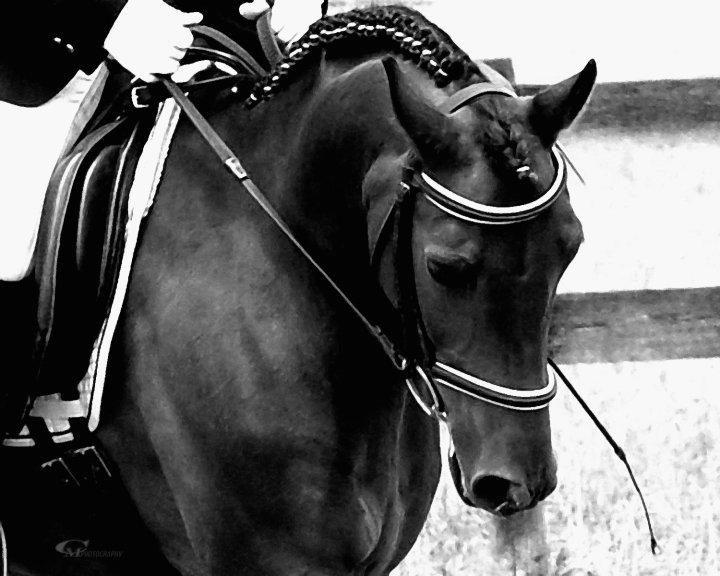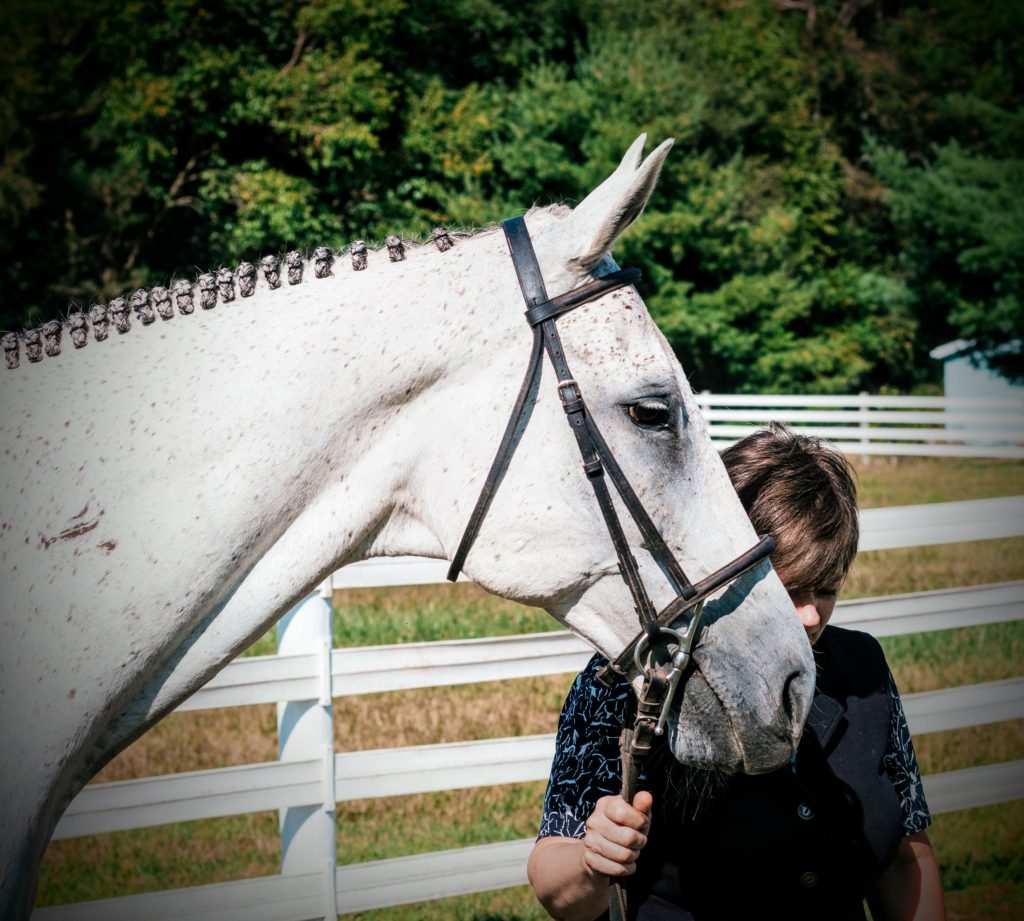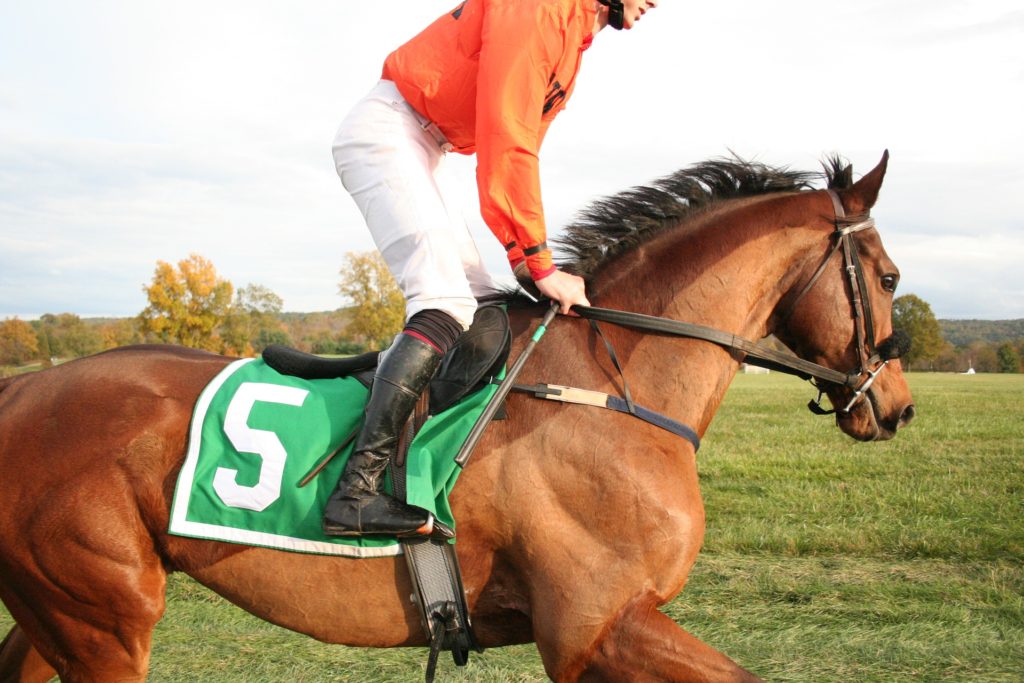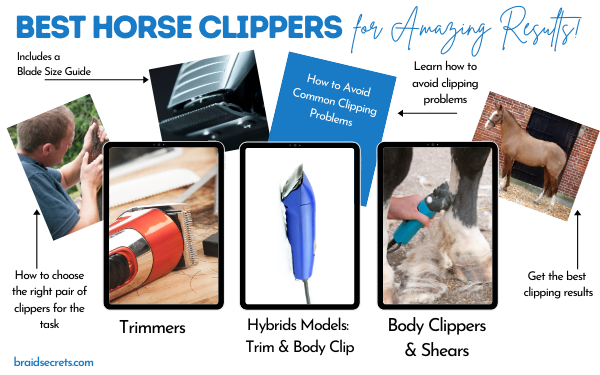Choosing the best horse clippers for trimming or body clipping, and avoiding common clipping problems are the keys to getting beautiful results. Below you’ll learn all about the different types of clippers including trimmers, hybrid models and body clippers. Plus, discover how to avoid clipping problems so that you can get amazing results on your horse.

Thanks for visiting Braidsecrets.com. As an avid equestrian (mostly dressage these days) I love to mention and link to various products and equipment that I use. Please assume those links are affiliate links which means I may earn a commission if you click and purchase. As an Amazon Associate I earn from qualifying purchases. Please see my disclosure for more information.
Clipping Challenge Story
I’ve done my fair share of timming and body clipping horses over the years. But when I decided to trace clip my large pony, Finnase, who always grew a crazy thick winter coat, I met my match.

My struggles began in the fall when I started riding Finnase indoors and he was sweating on his neck, chest and flanks. This made it difficult and time-consuming to cool him out.
Sound familiar? Yep, it’s a common problem when riding in cooler weather.
With daylight fading and the temperatures dropping, my concern grew about getting him cooled out. The biggest struggle was drying his haircoat. I spent as much time drying him off as I did riding.
Solving the Cool Out Dilema
I knew that I needed a long-term solution to avoid a repeat of this scenario after our daily rides and keep him healthy.
To solve the problem, I decided to trace clip Finnesse for the winter. A trace clip is a partial clip pattern that targets the areas where a horse sweats such as the lower part of the neck and the chest.
Best Horse Clippers to the Rescue
I planned out his trace clip by drawing a line with chalk on his neck and sides and began clipping below it. Even though I have experience clipping horses, my pony turned out to be real challenge to clip!
His thick coat grew in more directions than other horses I have clipped. And this made it an arduous task, since you always clip against the direction of hair growth to get smooth results.
Thankfully, I had one thing that allowed me to successfully clip him and get eye-appealing results.
An excellent pair of horse clippers.
With the right pair of clippers, clipping goes quickly and you can be proud of your sleek results. Choose the wrong pair of clippers, and clipping the hair becomes struggle, seems to take forever, and can look like a hack job when you’re done.
How can you ensure that trimming or body clipping your horse goes smoothly, quickly, and you get amazing results? Discover the information below about the various types of clippers, their designated use and how to avoid common clipping pitfalls.
Horse Clippers to Trim & Body Clip
Horse clippers generally fall into one of two categories: trimmers or body clippers. However, there are hybrid clippers that you can use to both trim and body clip a horse. Discover everything you need to know about the different types of clippers and their use in the sections below.
Best Horse Clippers for Trimming

Not planning to body clip your horse? In that case, a handy pair of horse clippers designed for trimming (aka trimmers) will make quick work of tidying up specific areas such as the ears, bridle path, and fetlocks. Trimmers have a vibrating motor that is less powerful than body clippers, but they’re also quieter.
Best Horse Trimmer Features
Quality trimmers should be powerful enough to easily cut the hair in limited areas and a leave a smooth appearance. They usually have a finer blade than body clippers for closer cutting. Trimmers are a handy and useful tool for outlining detail work such as when you are clipping a star shape into the haircoat on the haunches.
A good pair of trimmers are:
- Lightweight
- Easy to handle
- Quiet
- Cordless
- Less expensive than body clippers
I have used trimmers that gave poor results or purchased trimmers that only work well for a short period of time. To help you avoid these scenarios, check out my top pick for trimmers.
Hybrid Horse Clippers
Hybrid clippers that you can use to both trim and body clip a horse are a wonderful, dual-purpose grooming tool! These clippers are smaller than body clipping shears and handy for trimming on a low-speed setting. Yet, when you put that powerful motor on the high-speed setting, you can successfully complete a partial or full body clip. I used a pair of hybrid clippers with a special wide width size 10 blade on my pony.

If you only plan to clip a couple of horses, you’ll want to consider purchasing a hybrid clipper instead of body clippers.
Best Horse Clippers for Body Clipping

If you do a fair amount of body clipping, then you’ll want to purchase a pair of body clippers, also called shears. A quality pair of clippers in this category will be:
- Powerful
- Reliable
- Handy enough that they are easy to use for long periods of time
- Built to last
A quality pair of body clippers will cut through the haircoat effortlessly and quickly. The wide blades and powerful motor result in fast clipping, less strokes across the haircoat and fewer clipper marks. They are the best choice if you plan to body clip multiple horses. And a high quality pair will last for many years.
Note: If you’re not sure whether to do a partial clip or full body clip on your horse, see the paragraph after the next section on Deciding Whether to Body Clip.
Horse Clipping Problems
Below is a list of common horse clipping problems that riders often encounter.
1. Clippers lack the power needed for the task.
2. Clippers are pulling the hair instead of cutting it.
3. Clippers aren’t cutting the hair in a level manner.
4. Blades are leaving visible clipper marks when partial or full body clipping.
5. Clippers get hot quickly making your horse uncomfortable and resulting in poor cutting quality.
6. Clipper blades are cutting the hair too short.
In the next section, I’ll explain why these problems occur and how you can avoid them.
Why Clipping Problems Occur
Clipping a horse can be a time-consuming task and it requires attention to detail. Problems with clipper performance or technique are significant factors in how smoothly the process goes, the time is takes to complete, and how it looks when you are finished.
But clipping your horse doesn’t have to be a frustrating task if you choose the right pair of clippers, blade size and work in a systematic manner using a good technique. Read on to learn how to avoid common clipping problems.
1. Clippers Lack Power
One of the biggest frustrations riders encounter when clipping horses happens when undersized clippers are used for body clipping. For example, trimmers don’t have a powerful enough motor or the blade width suitable for body clipping.
Body clipping with trimmers is like trying to mow a large pasture with a push mower.
It’s going to take f-o-r-e-v-e-r!
Plus, most trimmers have a finer blade that will make the haircoat way too short when used for body clipping. So you put in all that effort to clip your horse, but your poor results are frustration and disappointing.
While choosing the right pair of clippers and blades will make quick work of the task and give you amazing results. Here’s the skinny on clipper types to help you choose wisely:
- Trimmers for perfect for tidying up small areas like the bridle path or fetlocks.
- Hybrid clippers can be used for both trimming and body clipping so they are the most versatile.
- Body clippers or shears are designed for partial or full body clipping your horse.
2. Clippers Pull Instead of Cut the Hair
When clipper blades are pulling the hair when cutting or instead of cutting, it is usually due to one of the following:
A. The clipper blades are dull, dirty or need lubrication.
B. The horse’s haircoat is dirty.
Realize that clipper blades must be super sharp to cut well. So if you plan to clip, check your blades in advance to avoid frustration. Dull blades can be sharpened by a service.
Blades must also be clean and oiled before clipping and very frequently (ever five to 10 minutes) while you are body clipping. Clean, sharp and well lubricated blades will reward you with superior results.
Ideally you should wash your horse (weather permitting) ahead of clipping so their haircoat is squeaky clean. Then apply a light grooming oil to their coat for the best clipping results. These steps not only allow you to get smooth results, but they help prevent dulling of your clipper blades as well.
3. Clippers Cut the Hair Unevenly
If the clipper blades are out of alignment, they won’t create a level cut across the haircoat. Check that your clipper blades are properly aligned, adjusted, and oiled according to the manufacturer’s manual.
Next, check your technique. In general, the back blade of the clippers should lay flat against the area you are clipping and glide smoothly along as you clip.
Tight areas will require some maneuvering and/or pulling the skin taught to clip them. For example, if you have another person hold your horse’s front leg up, the skin behind the elbow will be taunt and easier to clip smoothly without nicking your horse’s skin with the blades. If you tilt your hand slightly left or right when clipping, it can affect the levelness of the clip.
4. Blades Create Visible Clipper Marks
Properly adjusted, smooth-running clippers and your clipping technique are the two things that usually help prevent or minimize clipper marks. Clip in long smooth strokes against the hair growth rather than short choppy movements. You’ll have less issues with clipper marks if you employ this technique. Also, if you plan to show, clip your horse at least two weeks in advance so the haircoat looks it’s best in the show ring.
5. Clippers Get Hot Quickly and Cut Poorly
Refer back to my suggestions in number 2 above as hot clippers that cut poorly are usually the result of dull or dirty blades and/or a dirty haircoat.
6. Clipper Blades are Cutting Hair Too Short.
Using of the wrong blade size is what causes the haircoat to be clipped too short. In general (for hybrid model clippers), the higher the blade number the closer the cut. Below is an overview of what blade size to use when.
Clipper Blade Size Guide
A. The best blade choice for body clipping is typically a size 10 when using a hybrid clipper or a T-84 for large body clippers/shears. *See my note on quick-win wide size 10 blades below.
B. A size 15 blade is good for trimming
C. A size 30 blade for perfect for closer trimming
D. A size 40 blade is used by veterianrians to cut the hair very close to the skin prior to surgery, also called a surgical cut.
Quick-Win Wide Size 10 Blade
Wahl makes a special wide size 10 blade (10W) that attaches to a hybrid clipper and allows you to accomplish a partial or full body clip quicker. Some hybrid clippers feature a detachable blade which allows for quick-and-easy blade changes.
Wahl Size 10W Blade

What if you don’t want the hastle of purchasing different blades for each task? Check out the versatile 5-in-1 clipper blade model below.
Clipper with a 5-in-1 Blade
Don’t want to purchase different blades? Solve the problem with this awesome pair of clippers with a 5-in-1 blade that adjusts between sizes 9, 10, 15, 30, and 40, and offers a convenient variety of cutting lengths. Click the link to learn more and check out this cordless 5-in-1 blade model.
Best Horse Clippers to Avoid Clipping Problems
Clipping a horse only goes smoothly when you use a quality pair of clippers that are working properly and well suited for the task. Outlined below are my top picks for trimmers, hybrid clippers and body clipping shears that I have found give great results. Plus, I’ve included information on clipping oils, lubricants and blade wash.
Note: That some clippers in this post are not designed for international use, so please check the descriptions carefully.
Horse Clipper for Trimming
Top Pick: Wahl BravMini+ Trimmer

Why I love this trimmer – They are lightweight, quiet for sensitive horses and powerful with 100 minutes of cordless operation. Nice in your hand. Comes with an adjustable snap-on clipper guide so hair length can be customized which makes them versatile. These clippers are an essential grooming tool.
Best Hybrid Horse Clippers – Trim & Body Clip
My top pick for a cordless hybrid clipper is the:
Wahl Professional Animal Arco Equine Clipper

Here’s Why I love this clipper: This hybrid clipper is an economical choice because it serves a dual purpose (trimming and body clipping), and in my experience will last much longer than a trimmer model. They are lightweight, cordless and have a more powerful, long-lasting motor which makes them worth the investment.
Corded Horse Clippers to Trim & Body Clip
Option 1: Oster A5 with Detachable Blades

Why I Love This Corded Hybrid Model: Another pair of hybrid clippers that I can personally vouch for is the Oster A5. I love the detachable blade feature and I have found their performance to be super reliable over many years of use.
Option 2: Wahl Professional Animal KM2 Clipper Kit
Check out the impact-resistant, corded model shown below which comes with a detachable size 10 blade and is a super value.

Handiest Horse Body Clippers
Top Pick: Lister Star Body Clippers

Why I love this clipper: They’re lighter and handier to use that larger shearing models. And this is an advantage when clipping around tight areas such as your horse’s legs and chest area. These clippers are often the go-to model of professional braiders and grooms who do a great deal of body clipping. That endorsement speaks for itself.
Large Body Clipping Shears
Top Pick: Oster Body Clipping Shears
These shears come in a kit with a toolbox case and feature:
- A new durable, shatter-proof housing, 30% lighter than previous housing
- Superior balance for improved maneuverability and less fatigue
- Variable Speed Settings from 700 – 3000 strokes per minute
- Single Speed Setting – 3000 strokes per minute
- New textured finish for the most secure grip
- Here’s what is included in the kit: Clipping machine with 3” head, 83AU top blade, 84AU bottom blade (good for body clipping), Durable toolbox case with removable storage tray and blade compartments, Brush, grease and extra intake screen.

Why I love this model: Even the hairiest beast can be tamed by these body clippers! If you want to complete a partial or full body clip in record time, no clippers are faster. These clippers are durable which makes them worth the investment. Every rider that I know that has a pair has been using them for many years.
Best Horse Clipper Products: Oil, Lubricant & Blade Wash
You might be curious about the difference between clipper oil, spray lubricant and blade wash. Read on to learn which blade care products should you use and when.
Clipper Oil
A clipper oil is applied to clipper blades before use and every five to 10 minutes during clipping to ensure less friction and heating of blades and for optimal clipper function. Clipper oil is also applied after you have cleaned your clipper blades prior to storing them since applying oil to the blades helps to protect and keep them in good working order. Clipper oil the most important product to have and use for any clipping task.

Lubricant Spray
A spray lubricant is lighter weight than clipper oil. It is applied to blades during clipping for smoother and faster blade action. It’s convenient to use, however, it’s not a substitute for clipper oil.

Blade Wash
Blade wash helps remove excess hair between blades or residue from factory-applied preservatives that impede the cutting process.
How to Wash Clipper Blades
- Put a small amount of blade wash into a shallow container.
- Submerge just the clipper blades (while running) into the wash solution for 10 or 15 seconds to clean them. Don’t immerse any other part of the clippers.
- Dry off the blades and apply clipper oil to blades and rails (the part the blades slide on on some clippers) prior to storage.

Deciding Whether to Body Clip
A full body clip is a good choice for horses that show in the winter. Not showing? A partial clip works well for most horses in regular work.
You can customize a partial clip pattern to suit the needs of the individual horse, so that you only clip where your horse sweats. To determine whether or not to clip your horse and what type of clip pattern is most suitable, consider your response to the following questions:
How frequently do you ride?
If you ride on a regular basis clipping can be super useful. Are occasional rides are more your reality? If yes, then you may want to skip clipping and commit to spending extra cool out time after you ride. Just be ready to towel dry wet areas accordingly.
Where does your horse sweat?
Common areas are the chest, neck and flanks. Take note of your horse’s sweat patterns as these are the areas your clip should cover. I have customized trace clip patterns to suit my horses with great success. It is a super option since it leaves your horse with more of their natural coat and gives you the ability to cool your horse out quickly.
Can you commit to blanketing your horse in changing weather?
Do you have the proper blankets (such as a waterproof turn out sheet and a winter blanket, etc.), so that you can protect your horse after clipping? Note that even partially clipped horses have blanketing requirements. Heres’ my top pick for medium-weight winter blankets:
**Tough-1 1200 Denier Blanket

Why I love this Blanket: Of all the winter blankets I have tried over the years, my favorite is the Tough-1 1200 Denier Blanket shown below in royal blue (comes in several colors). This medium-weight blanket meets or exceeds the six criteria above and provides a superb fit, all at an unbeatable price.
Need help with blanket size selection? All you have to do is measure your horse from the center of the chest to the tail. As an example, my 16.1 hand gelding Dusty, wears a 78-inch blanket. Measure your horse prior to purchasing a blanket so that you get a proper fit.
Frequently Asked Questions About Clipping
Which horse clippers are the best?
Choosing the best horse clippers depends on your intented use. Listed below are the best choice for each type of clipper. These clipper models range from trimmers used to clean up small areas, to hybrid clippers for trimming and body clipping to body clipping shears. Check out these top picks:
This awesome trimmer.
This versatile and handy hybrid clipper.
This hard-working, durable body clipper (shears)
What are the quietest horse clippers?
Wahl Professional Animal Figura Equine Horse Cordless Clipper
The Figura Clipper (Kit) takes top honors because it is quiet, cordless, and has a lithium-ion battery with a top-notch adjustable 5-in-1 blade. These features along with an ergonomic design combine to provide stand out results.

What is the difference between trimmers and clippers?
Trimmers
Most riders use trimmers for detail clipping such as edging, outlining, and dry shaving small areas like a bridle path. Because trimmers have a finer blade that cuts close to the skin, they are most often used to tidy up a horse’s appearance. A trimmer has a vibrating motor that is less powerful than body clippers.
Body clippers
The main difference between body clippers and trimmers is that body clippers have a much more powerful motor. They’re designed for bulk hair cutting over larger areas. Typcially, body clippers come with either a size 10 or T-84 blade that doesn’t cut as close to the skin as a trimmer’s fine blade. As a result, the horse retains a short, sleek haircoat when body clipped.
Takeaways: Best Horse Clippers
Above all, an appropriate pair of clippers is essential so that you can successfully trim targeted areas or complete a full body clip.
First, start by selecting a trimmer, a hybrid model or a body clipper that’s designed for the grooming task you’re undertaking with your horse.
Second, you can avoid common clipping pitfalls by doing the following:
1. Start with a clean haircoat that has been conditioned with a light grooming oil.
2. Use an appropriate-size, sharp pair of clipper blades.
3. Lubricate clipper blades frequently with clipping oil every five to 10 minutes.
4. After clipping, clean your clipper blades with blade wash, and dry off the blades. Apply clipper oil to the blades and rails. As a result, your clipper blades will be protected so they last and function their best the next time you use them.
End of the Story
In conclusion, my clipping story has a happy ending because my pony’s trace clip was super functional. It allowed me to cool out and dry him off quickly. Plus, he looked amazing! If you follow these simple guidelines, they will help you accomplish superior horse clipping and care.
I hope you find this information on the best horse clippers and how to avoid common clipping problems helpful. Feel free to share it with your horse-loving friends.
Have you completed a clip yet? How did it go? Leave a comment and let me know!
Cheers!

P.S. I just received the most awesome horsey gift ever! It’s a Pivo Silver that can track and record video of my rides using my phone. What an amazing training tool. I can’t wait to try it out. It’s getting rave reviews from fellow riders.


Thanks for sharing!! Enjoyed your article!!
Thank you Terri! It took a long time to write about my experiences clipping and add in all that information about the various clippers that have worked for me. But it was a labor of love. I’m so glad you enjoyed the article!
Thanks for sharing this clipper information! You have helped me make a decision how and what I need to purchase to get started. Happy riding to you Mary Beth.
Hi Cathie,
You are so welcome. I’m glad you found the clipper information helpful. Thanks for letting me know!
Pingback: Must-Have Top-Notch Tail-Tidying Clippers for Your Pup